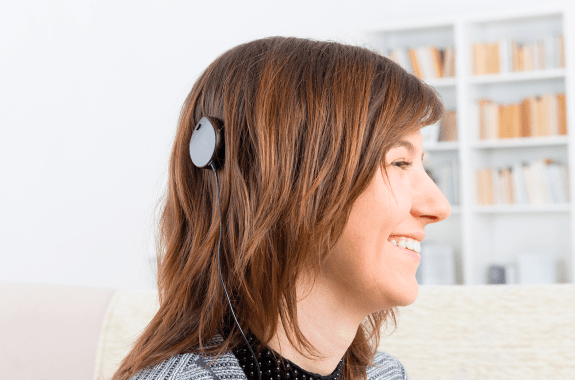Grade Level
6 - 8
minutes
1- 2 hrs
subject
Physical Science
Activity Type:
Simulation, technology, data collection, hearing
Listen carefully to the audio below. Can you make out the words being spoken by the voice?
The speech sounds different from what you’re used to hearing, doesn’t it? This is a simulation of one example of what it can be like to hear sounds through a hearing aid—a device that helps people with hearing loss. Hearing aids use small computers to amplify and modify sounds so that they’re easier to hear. This computer-aided sound is slightly different than normal speech because it has been filtered, in the above case to remove frequencies of sound above 1500Hz.
Now listen to this simulation of what speech sounds like through a different type of hearing assistive technology called a cochlear implant:
A cochlear implant converts sound into electrical signals that can be interpreted by the brain.
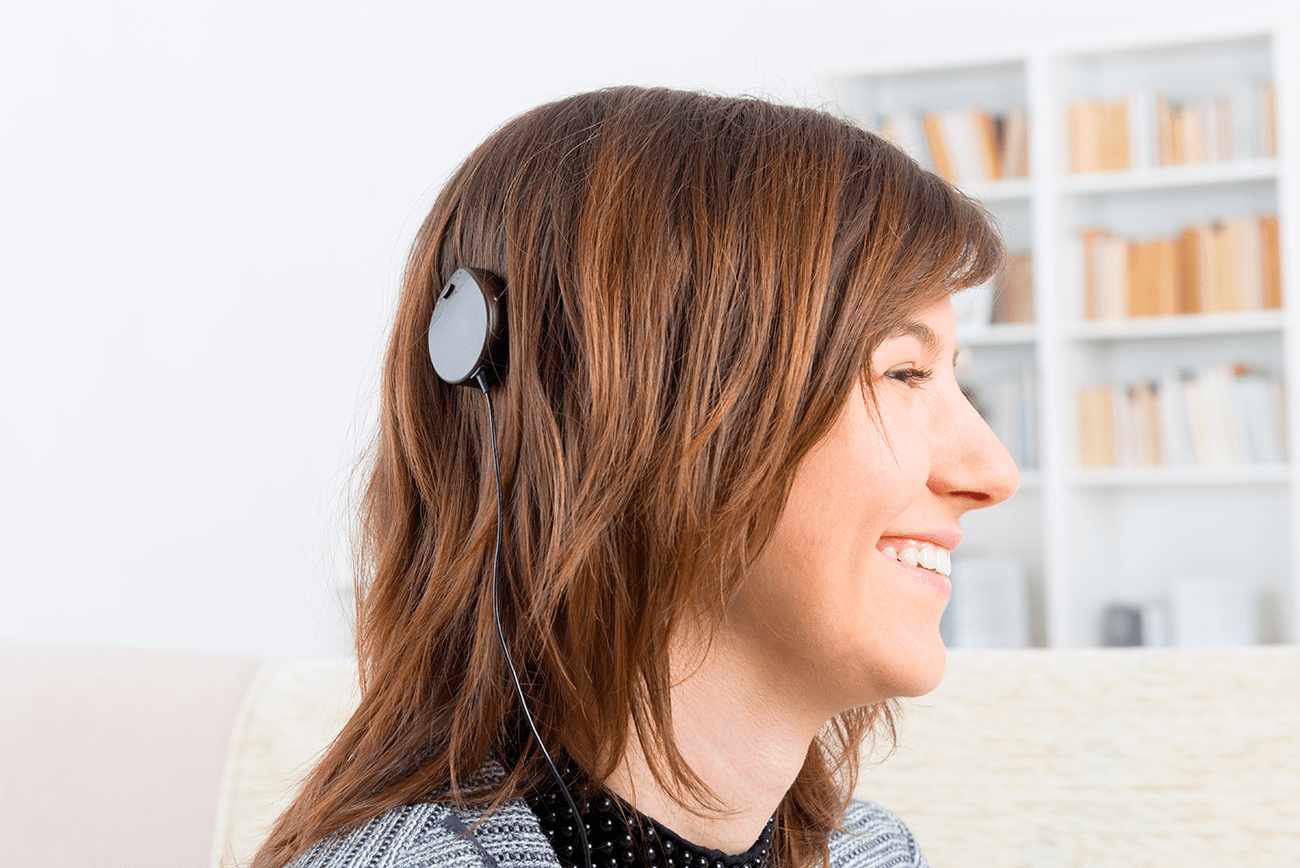
These simulations aren’t perfect, but they are helpful
These recordings are simulations of what it’s like to hear sound through a hearing aid and a cochlear implant. Unless you wear one of these devices, it is impossible to know exactly what it is like to experience sound through them. In fact, people who have normal hearing in one ear but wear a cochlear implant in the other ear say that these simulations sound very different from how they hear sounds with their implant. The reason is because the brain adapts to hearing sounds through the implant in a way that can’t be captured by a simulation. Still, simulations provide an idea of what it’s like to experience sounds using hearing assistive technologies.
So when should someone with hearing loss receive a hearing aid, a cochlear implant, or both? How do audiologists—that is, scientists who study hearing—decide?
Ready to dive in? Let’s start with hearing basics.
Print out these ear diagrams and annotate them with each step of the listening process. Doodle, draw, and write little notes about where each step occurs in an unaided ear, with a hearing aid, and with a cochlear implant.
Donate To Science Friday
Invest in quality science journalism by making a donation to Science Friday.
Hearing Basics
Sound is the transfer of energy in the form of waves through a substance, or medium, such as air or water. The length, height, and speed of a sound wave determine how a listener perceives the sound. The length of each wave, or “wavelength,” and the speed that it travels determine the frequency of a sound, which we interpret as “pitch.” The height of each wave, called the amplitude, is what determines a sound’s volume.
In order for us to hear sounds, sound waves must enter our ear. The human ear converts sound from mechanical wave energy into electrical impulses that can be interpreted by the brain. Many structures within the ear are involved in hearing, each serving a specific function.
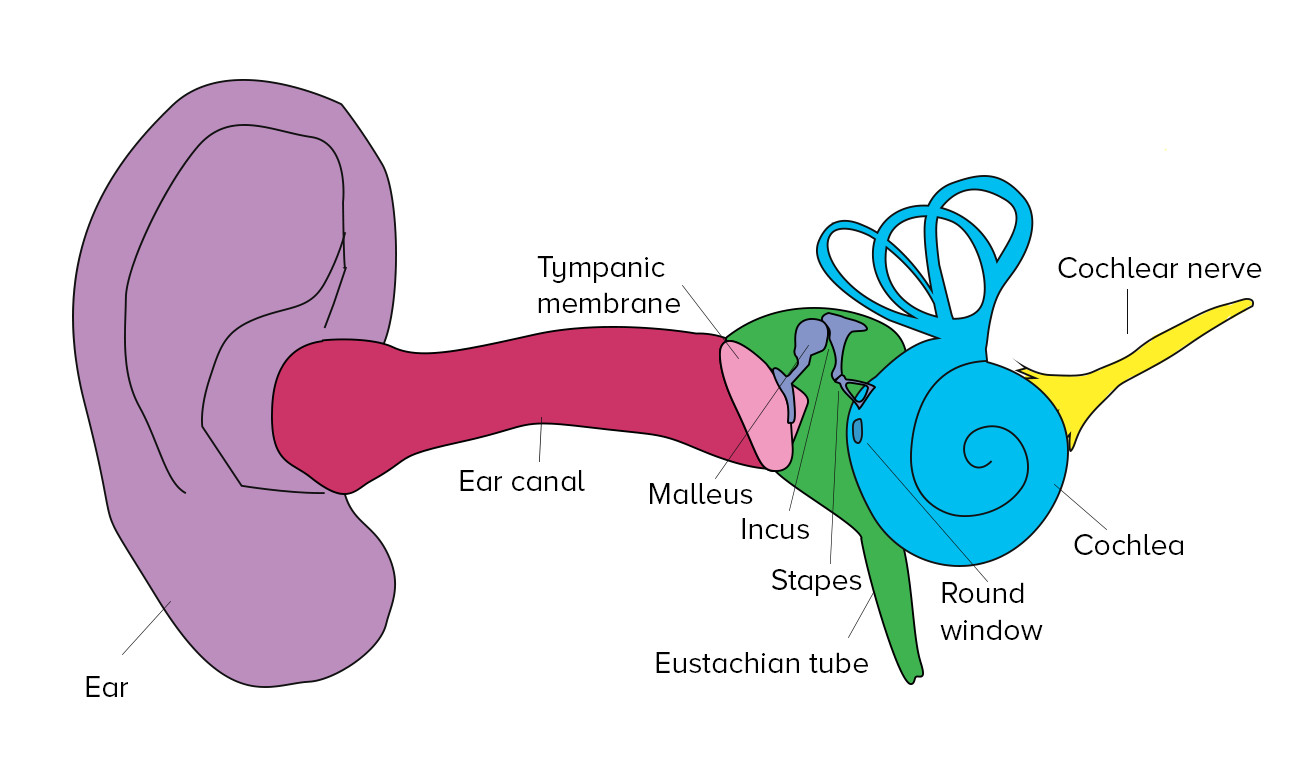
- Sound enters the outer ear and travels through the ear canal.
- The sound waves press against the tympanic membrane, or “ear drum,” causing it to vibrate.
- Vibrations of the ear drum push against a series of three small bones—the malleus, incus, and stapes¬—moving them back and forth.
- The movement of the stapes against the cochlea transmits pressure waves into the fluid within the cochlea, causing the fluid to vibrate.
- The fluid vibrations cause tiny hair cells located within the cochlea to move gently back and forth. As the hair cells move, they release chemical signals that stimulate nerve fibers near the cochlea.
- The nerve fibers transmit the signals to the auditory nerve and on to the brain.
How does hearing loss occur?
If parts of the middle and inner ear become damaged—perhaps due to injury or illness—a person can lose some or all of their ability to hear. Hearing loss occurs most commonly when loud sounds cause damage to the delicate hair cells in the cochlea, but drugs or medications, as well as early-life infections, can also damage hair cells or the cochlea itself. In other cases, people are born without the ability to hear due to malformation or absence of inner ear structures.
Take a moment to think about all the ways that you rely upon your hearing, whether in a classroom, at work, or with friends. What would it be like to suddenly lose your hearing, and how would it affect you? For those who suddenly lose their hearing, the change can make it hard to enjoy music, converse with friends and family, and be aware of their surroundings. Hearing assistive technology can help those with hearing loss overcome these challenges. Two main types of hearing devices are commonly used: hearing aids and cochlear implants.
Breakthrough: Hearing A Whole New World
How Hearing Aids Work
Hearing aids work a bit like a microphone and a speaker, but they are much, much smaller! There are many kinds of hearing aids, but what unites them is that they make sounds louder, and hence easier to hear, for people who have partial hearing loss.
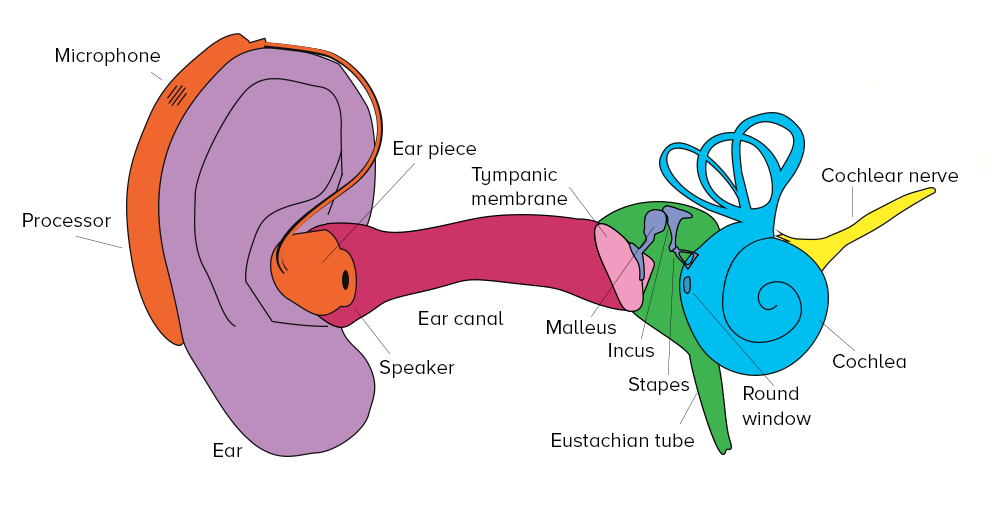
- The hearing aid uses a microphone to pick up sound from the environment and convert it into electrical signals.
- A small computer processor modifies the electrical signals by using filters to dampen carefully selected frequencies such as those associated with background noise so that speech can be heard more clearly.
- An amplifier strengthens the filtered signal before transmitting it to a speaker located in an earpiece worn in the ear.
- The speaker converts the signal back into sound that is broadcast into the ear canal.
- The sound is transmitted through the normal hearing pathway via the eardrum, malleus, incus, stapes, and cochlea, at a volume that is loud enough to be detected by hair cells in the cochlea and which can be adjusted by the wearer.
- As the hair cells move, they release chemical signals that stimulate nerve fibers near the cochlea.
- The nerve fibers transmit the signals to the auditory nerve and on to the brain.
Because hearing aids play amplified sound into the ear canal, wearers must still have some ability to hear in order to detect the modified sounds coming from the hearing aid speaker.
The small computer processors in hearing aids are designed to distinguish between sounds of interest and background noise based on their frequencies. The processors modify the quality of sound by amplifying some frequencies (like those associated with a conversation) and dampening others (like those associated with the noise in a crowded restaurant). A computer program that removes or dampens sound above or below a certain frequency is called a filter. Filters can be personalized to the hearing needs of the wearer. To get a sense of how acoustic filters modify sound, listen to the following two hearing aid simulations. Each one filters different frequencies of sound:
250 Hz low-pass filter
This filter removes all frequencies above 250 Hz
1500 Hz low-pass filter
This filter removes all frequencies above 1500 Hz
How Cochlear Implants Work
Cochlear implants work by converting sounds into electrical signals, which are sent to the nerves surrounding the cochlea and interpreted by the brain as sound. Cochlear implants do not play sound to the wearer, and so they can be useful even if that person has little or no ability to hear sound.
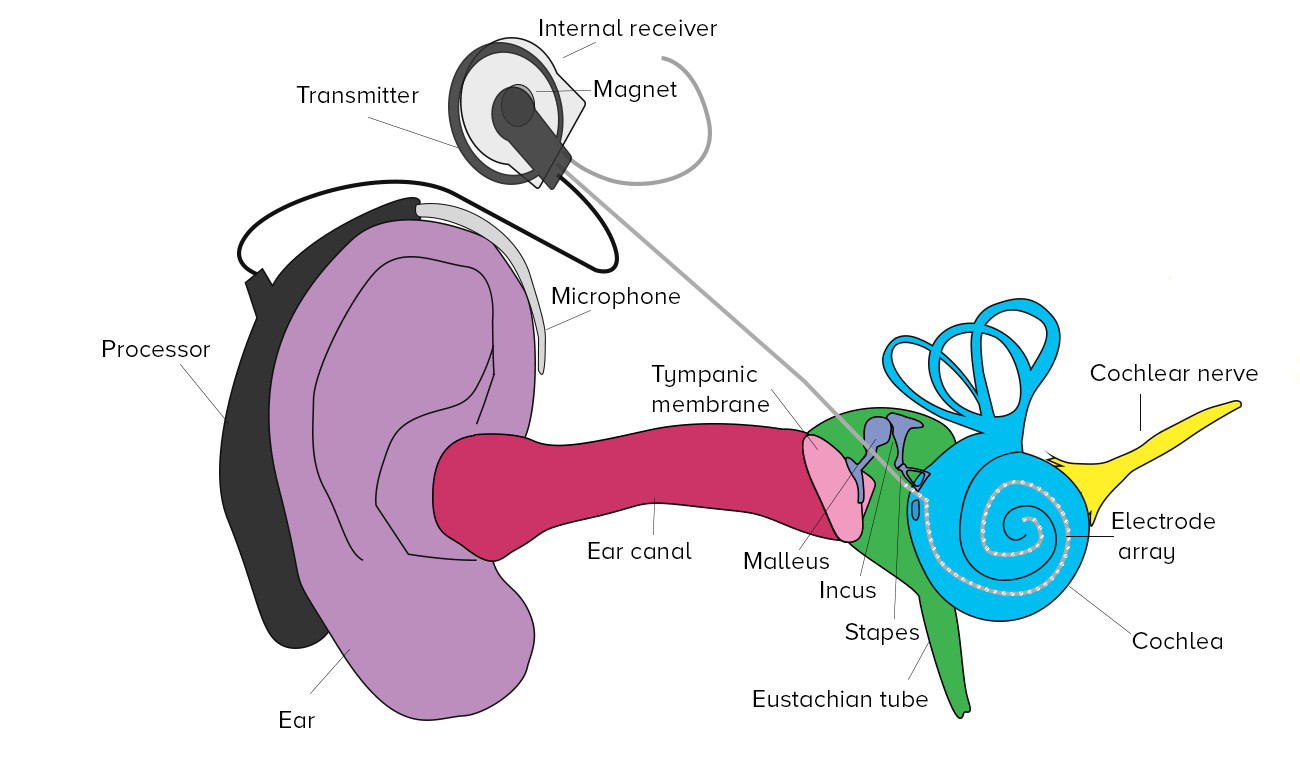
- A microphone that is worn on the back of the ear detects sounds in the surrounding environment and converts them into electrical signals.
- The signals are sent to a small computer processor that selects and amplifies certain frequencies to make speech easier to interpret.
- Those signals are passed to a transmitter attached to the outside of the head with a magnet.
- The transmitter sends the signals to a receiver that has been surgically placed under the skin, above the ear.
- The receiver sends the signals into the inner ear, along a cable, to a series of electrodes, or “electrode array” implanted directly in the cochlea.
- The signals generate electrical impulses along the electrodes that stimulate the nerve fibers surrounding the cochlea, which in turn stimulate the auditory nerve, sending nerve signals to the brain.
Cochlear implants differ from hearing aids in two key ways. First, electrical signals are transmitted directly to nerve fibers in the auditory nerve, bypassing the outer and middle ear entirely. That means that the brain can detect signals from the implant even if the ear bones, cochlea, and hair cells are non-functioning, making implants effective even for people with profound hearing loss. Second, unlike hearing aids, which are fitted and worn externally, the receiver and electrode of a cochlear implant must be surgically placed under the skin, into the cochlea itself.
Donate To Science Friday
Support science and journalism and participate in the act of giving this #GivingTuesday with a donation to Science Friday.
Hearing Aid, Cochlear Implant, Or Both?
The differences between how cochlear implants and hearing aids work and how they are fitted has for a long time meant that they are used independently of one another.
Cochlear implants require surgical implantation, and so have traditionally been recommended only for people with profound hearing loss. On the other hand, hearing aids have typically been recommended for people with moderate hearing loss, because they’re easy to use and require at least partial hearing in order to be effective.
But what if someone used both a cochlear implant and a hearing aid at the same time? Would they be able to interpret the sounds around them any better than if they just used a hearing aid or a cochlear implant alone? Could the acoustic filters in a hearing aid provide additional benefit to someone with a cochlear implant? To answer these questions, researchers can test the speech recognition of hearing subjects as they listen to cochlear implant and hearing aid simulations.
Here’s the general procedure that researchers used: Researchers fit hearing subjects with headphones and play simulations of speech as heard through a cochlear implant, or a cochlear implant paired with a hearing aid. With this approach, researchers can also modify the low-pass frequency filters used by the hearing aid (filters that remove frequencies above 250Hz, 500Hz, 750Hz, 1000Hz, and 1500Hz) to determine which filters might best complement a cochlear implant. Subjects are asked to write down the words they hear, which researchers later score to determine the percentage of words heard correctly.
Conduct a Listening Experiment Yourself.
You can conduct your own version of the type of the simulation experiment described above. You’ll hear shortened simulations of a hearing aid, a cochlear implant, and a hearing aid and a cochlear implant combined, and record the words you hear. After you’ve heard all of the simulations, you’ll use a key to score how well you understood speech from each simulation.
- Download this response sheet where you will write down the words and phrases that you hear.
- Using headphones, listen to each of the experimental simulations of speech below. Each simulation consists of a female voice speaking with background voices that are male. Focus on trying to understand the words spoken by the female voice. Write the words that you think you heard spoken by the female voice on the response sheet.
- Use this speech simulation answer sheet to score which words you got correct and which you did not, then calculate the percentage of words you got correct for each simulation. To make calculations easier, record your scores in the spreadsheet version of the answer sheet.
- Optional: repeat the experiment with other listeners if you would like to calculate an average for each scenario.
- Graph the percentage of words you got correct for each simulation on this chart, listing the different testing conditions in the order in which they appear below.
Condition 1: CI in noise
Condition 2: CI + 250Hz hearing aid filter in noise
Condition 3: CI + 500Hz hearing aid filter in noise
Condition 4: CI + 750Hz hearing aid filter in noise
Condition 5: CI + 1000Hz hearing aid filter in noise
Condition 6: CI + 1500Hz hearing aid filter in noise
Interpret Your Results
- Which condition resulted in your highest percentage of words correct? Which condition resulted in the lowest score?
- How does listening to audio through a hearing aid as well as a cochlear implant change your ability to recognize speech in a noisy environment? How can you tell?
- If you conducted this test with another person, which simulation resulted in your highest score? Was it the same simulation? Why might your results differ?
- Is there a frequency of hearing aid filter that you would most likely recommend to patients with cochlear implants? Why?
- How would your recommendations change for someone who had no ability to hear at all?
Compare your results to findings from another study
Look at the bar chart below of the results of a similar study conducted by members of Rene Gifford’s Cochlear Implant Research Laboratory at Vanderbilt University. This particular data shows the average % of words heard correctly by 19 children with normal hearing using a similar set of simulation conditions.
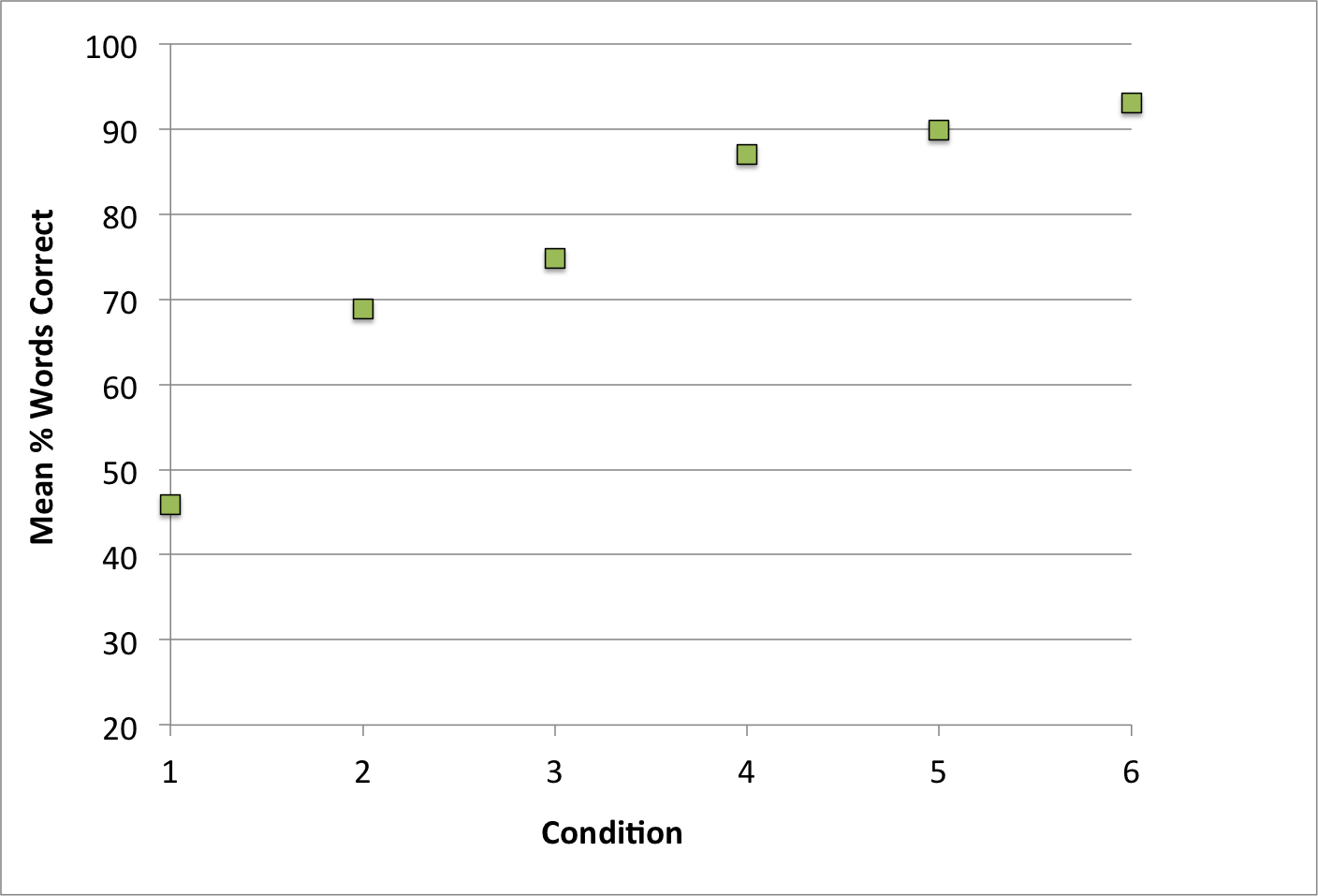
- How is your hearing experiment setup differently from what was performed by the Gifford Lab group? Which one would you suspect might produce more reliable results? Why?
- Look at the results from the study above: Which condition resulted in the highest percentage of words correct? Which condition resulted in the lowest score?
- Compare the graph of your results with those above. How are your results different from the results presented in the chart above? Did the same condition lead to the highest percentage of words correct?
- Based on the data presented in the graph above, what hearing aid acoustic filter would you recommend for use with a cochlear implant for kids with partial hearing?
Extension: Write a recommendation to the American Academy of Pediatrics about whether cochlear implants alone, hearing aids alone, or some combination of the two should be recommended for children. Indicate how children could be screened for the best type of hearing assistive device for them, making sure to reference the results of your independent study as well as the results of the study done by Dr. Gifford’s research group.
What Is It Like to Hear With A Cochlear Implant?
One summer, Allyson was in a car accident that totaled her car and left her in the hospital. After months of rehabilitation and recovery from her visible injuries, she woke up one morning and knew her life was different. Her dog Maddie jumped, started barking, and ran across the room, but Allyson heard nothing. She picked up the phone and listened for a dial tone, but again, nothing. Though Allyson had grown up with partial hearing and used hearing aids most of her life, her car accident had sent her into a life of complete silence. Allyson had lost her hearing entirely.
Learn more about Allyson’s experience, and how research from Rene Gifford’s lab enabled her to continue to pursue a career in audiology, in this video produced by Science Friday and Howard Hughes Medical Institute:
Next Generation Science Standards
This resource can be used to make progress towards the following performance expectations:
MS-PS4-2
Develop and use a model to describe that waves are reflected, absorbed, or transmitted through various materials.
MS-PS4-3
Integrate qualitative scientific and technical information to support the claim that digitized signals are a more reliable way to encode and transmit information than analog signals.
Common Core State Standards
ELA RST.6-8.9
Compare and contrast the information gained from experiments, simulations, video, or multimedia sources with that gained from reading a text on the same topic. (MS-PS4-3)
MATH.CONTENT.6.SP.B.4
Display numerical data in plots on a number line, including dot plots, histograms, and box plots.
MATH.CONTENT.6.SP.B.5
Summarize numerical data sets in relation to their context
Many thanks to Kristen D’Onofrio and Rene Gifford of the Cochlear Implant Research Laboratory in the Department of Hearing and Speech Sciences at Vanderbilt University for their assistance with the simulations and research shared in this resource.
Teachers who field tested this resource had the following advice for teachers adopting this resource:
Lora from Texas said: The video was very well done, loved the comparison, opportunity to graph results and pre/post test and reflection questions. I recommend copying ear diagrams two photos per page so students can easily compare and draw pathways. You can also copy response questions into Google doc and walk students through intro and conclusions instead of it being self-paced.
This article was revised 4/21/2017 to correctly indicate that the filters that have been applied to the hearing aid simulations are low pass filters, which remove all frequencies above the indicated frequency, not below.
Educator's Toolbox
Meet the Writer
About Ariel Zych
@arieloquentAriel Zych is Science Friday’s director of audience. She is a former teacher and scientist who spends her free time making food, watching arthropods, and being outside.
